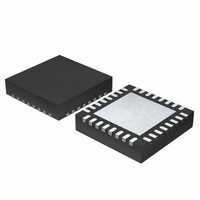ISL6569CRZ-T Intersil, ISL6569CRZ-T Datasheet - Page 9

ISL6569CRZ-T
Manufacturer Part Number
ISL6569CRZ-T
Description
IC CTRLR PWM BUCK 2PHASE 32-QFN
Manufacturer
Intersil
Datasheet
1.ISL6569CBZ.pdf
(22 pages)
Specifications of ISL6569CRZ-T
Pwm Type
Controller
Number Of Outputs
1
Frequency - Max
2MHz
Duty Cycle
75%
Voltage - Supply
4.75 V ~ 5.25 V
Buck
Yes
Boost
No
Flyback
No
Inverting
No
Doubler
No
Divider
Yes
Cuk
No
Isolated
No
Operating Temperature
0°C ~ 70°C
Package / Case
32-VQFN Exposed Pad, 32-HVQFN, 32-SQFN, 32-DHVQFN
Frequency-max
2MHz
Lead Free Status / RoHS Status
Lead free / RoHS Compliant
representing an individual channel’s peak-to-peak inductor
current.
In Equation 1, V
voltages respectively, L is the single-channel inductor value,
and f
The output capacitors conduct the ripple component of the
inductor current. In the case of multi-phase converters, the
capacitor current is the sum of the ripple currents from each
of the individual channels. Compare Equation 1 to the
expression for the peak-to-peak current after the summation
of two symmetrically phase-shifted inductor currents in
Equation 2.
Peak-to-peak ripple current decreases by an amount propor-
tional to the number of channels. Output-voltage ripple is a
function of capacitance, capacitor equivalent series resis-
tance (ESR), and inductor ripple current. Reducing the induc-
tor ripple current allows the designer to use fewer or less
costly output capacitors.
Increased ripple frequency and lower ripple amplitude mean
that the designer can use less per-channel inductance and
lower total output capacitance for any performance
specification.
Another benefit of interleaving is to reduce input ripple
current. Input capacitance is determined in part by the
maximum input ripple current. Multi-phase topologies can
improve overall system cost and size by lowering input ripple
current and allowing the designer to reduce the cost of input
capacitance. The example in Figure 3 illustrates input
currents from a two-phase converter combining to reduce
the total input ripple current.
I
I
PP
C PP
,
FIGURE 3. CHANNEL INPUT CURRENTS AND
=
S
=
(
----------------------------------------------------- -
is the switching frequency.
V
(
---------------------------------------------------------- -
IN
V
CHANNEL 1
INPUT CURRENT
10A/DIV
IN
–
L f
V
–
INPUT-CAPACITOR CURRENT, 10A/DIV
INPUT-CAPACITOR RMS CURRENT FOR
3-PHASE CONVERTER
OUT
S
2 V
L f
V
IN
S
IN
OUT
) V
V
and V
CHANNEL 2
INPUT CURENT
10A/DIV
IN
OUT
) V
OUT
OUT
1µs/DIV
are the input and output
9
(EQ. 2)
(EQ. 1)
ISL6569
The converter depicted in Figure 3 delivers 36A to a 1.5V load
from a 12V input. The RMS input capacitor current is 8.6A.
Compare this to a single-phase converter also stepping down
12V to 1.5V at 36A. The single-phase converter has 11.9A
RMS input capacitor current. The single-phase converter
input capacitor bank must support 38% more RMS current
than an equivalent 2-phase converter.
Figure 16 in the section entitled Input Capacitor Selection
can be used to determine the input-capacitor RMS current
based on load current, duty cycle. It is provided as an aid in
determining the optimal input capacitor solution.
PWM Operation
One switching cycle is defined as the time between PWM1
pulse termination signals. The pulse termination signal is an
internally generated clock signal which triggers the falling
edge of PWM1. The cycle time of the pulse termination
signal is the inverse of the switching frequency set by the
resistor between the FS/DIS pin and ground. Each cycle
begins when the clock signal commands the channel-1
PWM output to go low. The PWM1 transition signals the
channel-1 MOSFET driver to turn off the channel-1 upper
MOSFET and turn on the channel-1 synchronous MOSFET.
The PWM2 pulse terminates 1/2 of a cycle after PWM1.
Once a PWM signal transitions low, it is held low for a
minimum of 1/4 cycle. This forced off time is required to
ensure an accurate current sample. Current sensing is
described in the next section. After the forced off time
expires, the PWM output is enabled. The PWM output state
is driven by the position of the error amplifier output signal,
V
sawtooth ramp as illustrated in Figure 1. When the modified
V
transitions high. The MOSFET driver detects the change in
state of the PWM signal and turns off the synchronous
MOSFET and turns on the upper MOSFET. The PWM signal
will remain high until the pulse termination signal marks the
beginning of the next cycle by triggering the PWM signal low.
SAMPLED
CURRENT
COMP
COMP
SAMPLE
HOLD
FIGURE 4. CHANNEL 1 INTERNAL AND EXTERNAL
ISL6569 INTERNAL CIRCUIT
&
I
1
, minus the current correction signal relative to the
voltage crosses the sawtooth ramp, the PWM output
I SEN
=
CURRENT-SENSING CIRCUITRY
I
L1
r
------------------------- -
+
-
DS ON
R ISEN
(
)
ISEN1
EXTERNAL CIRCUIT
CHANNEL 1
LOWER MOSFET
R
ISEN
V
IN
+
CHANNEL 1
UPPER MOSFET
-
I
L1
December 29, 2004
r
DS ON
I
L1
(
FN9085.7
)











